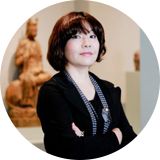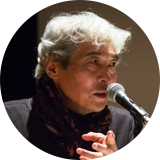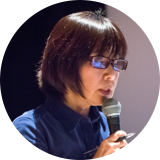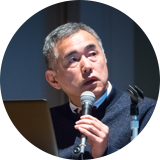SEA PROJECT Symposium
How has Japan Engaged with Contemporary Art in Southeast Asia? Panel Discussion and Q&A (2/4)


Mr. Shimoda, your perspective may differ a little since you are here as an artist. Last year, while we were traveling across the ASEAN regions――meeting artists, art space managers, and key figures in the arts from the 1980s and ’90s――we also met many performance artists. Asking them what triggered them to pursue their practices, nine out of ten responded, “Seiji Shimoda.” It was evident that you were the one who ignited the idea of performance in the region, and we saw that the fire still continues to burn today. What changes have you observed over the past twenty years? Can artists perform more openly and in “official” venues in Myanmar, for example, now that it is undergoing political transformation?
As you said, I am an artist, and I think that an artist is someone who does anything and everything. By that, I mean that it is enriching for any artist to pursue different methodologies of artistic expression, performance or otherwise. Today, we have the convenience of the internet; but back then, information that a freewheeling person like myself brought was very new for the people in Asia and Southeast Asia. Something as simple as showing videos and talking to them about what I had seen was enough for them to quickly initiate their own ideas. Information was something they craved. Naturally, performance doesn’t make a lot of money, so a lot of people chose to return to painting. Despite that, there are now definitely more artists who believe that performance art is the closest art form that epitomize the essential spirit of an “artist,” so I am hoping to work closely with those people toward the next steps.
We saw a video earlier of Tran Luong, a Vietnamese artist , who has been highly praised for his curatorial work in the Mien Meo Mieng / Contemporary Art from Vietnam exhibition held at Umeå University’s Bildmuseet in Sweden in 2015. The fact that Tran Luong is an artist, curator, and organizer is, I found, a very interesting characteristic; that a single person serving more than role certainly opens up new ways of engaging with art projects.
Yes, you’re right. It’s also true for Japan; the ones who best know how to organize and plan performance events and exhibitions are, in fact, the artists. Museums can function well as spaces, but programs tend to end up being simply classical concerts or conventional dance shows.

Ms. Furuichi, you have been organizing Run & Learn, a workshop geared for young curators and artists where you call for exhibition proposals, hold sessions with the applicants to polish them up, and finally select a few which are to be realized as exhibitions. Throughout the workshop, did you discover any new or different issues of interests from the applicants compared to, say, a few decades ago?
Yes, circumstances differed and still differ in each of the countries. When I began working in Southeast Asian art, ASEAN consisted of six countries――Indonesia, Singapore, Thailand, the Philippines, Brunei, and Malaysia――but now there are ten. The backgrounds of the initial ASEAN members and those that later joined――Vietnam, Myanmar, Laos, and Cambodia――obviously are different. Therefore the exhibition proposals submitted are also naturally different according to each country: some applicants incorporated socio-political issues, while more commercial ideas come into play for others who come from areas where commercialism is more dominant. Rather than saying that things have changed, I find that it is more interesting to exhibit each of their dispersed interests as it is. The Under Construction: New Dimensions of Asian Art exhibition (2002-2003) pursued that similar method; each edition (or local exhibitions) were themed according to their own socio-cultural characteristics. That is how the different conditions of Asia become apparent. Run & Learn simply operates the same way.
At the same time, however, we also need to all work on improving curatorship as a profession. Even if you organize exhibitions, unless the curators “amp up their game” they won’t get through to audiences of each country or region. Earlier, Prof. Ushiroshoji mentioned how, back then, Japanese curators visited countries for research and exploited their resources for the benefit of exhibitions that were to be held in Japan. We need to address the question of how to gain access to or engage with the audiences in each country in order to expand the horizons of art. Meanwhile, there are also people who face difficulties in starting or developing their careers despite there already being facilities or infrastructures for artistic practices.
So what is always in the back on my mind, is how to work with each of their specificities, and, through human resources development, to not maintain but improved the current conditions of the Asian region (including Japan) as a whole. It is important to reflect on the role we serve in that respect.

We are, in fact, thinking of bringing those individual socio-historical and political differences to the fore in our 2017 exhibition. In “A Difficult Journey of Contemporary ASEAN Art”――written for the Narrative Vision in Contemporary ASEAN Art exhibition organized by the Japan Foundation’s then-ASEAN Cultural Center in 1990――, Prof. Ushiroshoji, you discussed the validity of grouping countries together as ASEAN. If I understood it correctly, you wrote that although each country pursued their own national identities and it seemed like that would result in a sort of dead-end, by grouping the countries as one unit, the complex cultural interactions among the countries may instead become visible. I believe there has already been a lot of discussion about the credibility of “ASEAN” and/or “Southeast Asia”, but what are your current thoughts on the issue?
As I said earlier, national identity was, at the beginning, the main focus of interest. However, if you travel Southeast Asia, you realize that cultural currents that interact within and also transgress national borders very much exist. For example, I was speaking to a young Chinese-Malaysian artist about a famous female Malaysian singer; although the singer happened to be Malay, the artist hadn’t even heard of her. But, the Chinese-Malaysian artist writes lyrics for a Taiwanese rock band. Whether it be through the overseas Chinese or Islamic ties, there are cultural instances that cross national borders which we need to carefully observe.
Thank you very much for your answers. For our 2017 exhibition, we have asked four Southeast Asian curators who were born in the 1980s to work with us. The exhibition’s timeframe extends from the 1980s to the present, and we intend to investigate this relatively-recent past through a historical lens. What are your reactions, Vera, Jo-Lene, Grace, and Merv, to today’s symposium as curators and artists who literally grew up in this period we are historicizing?
To Panel Discussion and Q&A (3/4)




